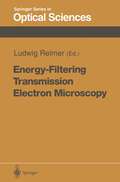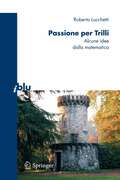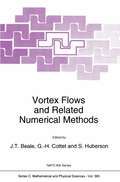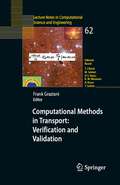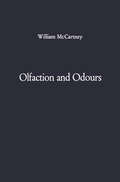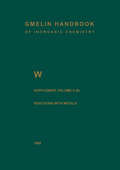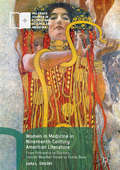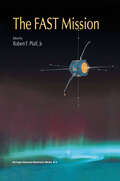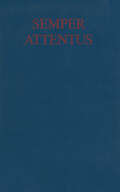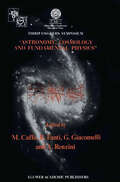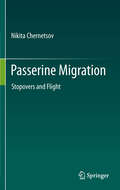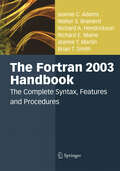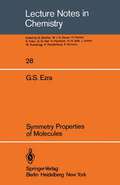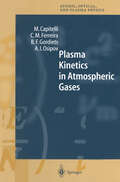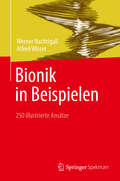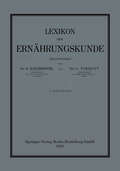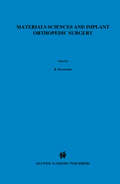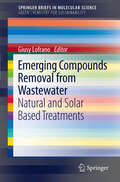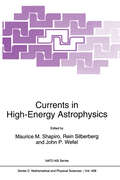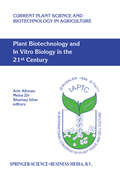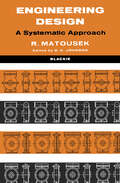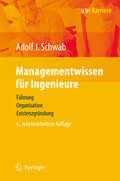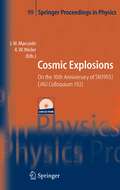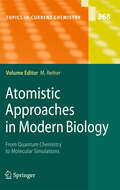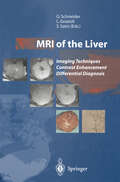- Table View
- List View
Energy-Filtering Transmission Electron Microscopy (Springer Series in Optical Sciences #71)
by P. W. Hawkes C. Deininger R. F. Egerton F. Hofer B. Jouffrey D. Krahl R. D. Leapman J. Mayer Ludwig Reimer H. Rose P. Schattschneider J.C.H. SpenceEnergy-Filtering Transmission Electron Microscopy (EFTEM) presents a summary of the electron optics, the electron-specimen interactions, and the operation and contrast modes of this new field of analytical electron microscopy. The electron optics of filter lenses and the progress in the correction of aberrations are discussed in detail. An evaluation of our present knowledge of plasmon losses and inner-shell ionisations is of increasing interest for a quantitative application of EFTEM in materials and life sciences. This can be realized not only by filtering the elastically scattered electrons but mainly by imgaging and analyzing with inelastically scattered electrons at different energy losses up to 2000 eV. The strength of EFTEM is the combination of the modes EELS, ESI, ESD and REM.
Passione per Trilli: Alcune idee dalla matematica (I blu)
by Roberto LucchettiÈ convinzione generale che la matematica sia una materia difficile da capire, che usa simboli esoterici e un linguaggio poco comprensibile, che sia soprattutto calcolo. Certamente, è una materia particolare, che ha bisogno di formule e che necessita di un linguaggio formale a volte molto sofisticato. Tuttavia, è anche una scienza piena di idee, che non hanno solo la funzione di progredire in una qualche teoria o di servire altre scienze per i loro modelli quantitativi. Come la filosofia, come la letteratura, la matematica è utile all’uomo per cercare di capire un po’ meglio il mondo che lo circonda, e soprattutto se stesso. Convinto profondamente di questo, l’autore propone alcuni argomenti, che sono particolarmente adatti a mettere in luce questo aspetto della matematica. L’autore utilizza, a volte, un linguaggio più matematico per completare il ragionamento, ma è del tutto convinto che il lettore interessato possa seguire tutti i suoi ragionamenti perché, parafrasando un grande matematico del secolo scorso, "chi non ha dimestichezza con le tecniche matematiche si renderà conto di potersela cavare senza problemi ignorandole del tutto" (J.F.Nash, jr).
Vortex Flows and Related Numerical Methods (Nato Science Series C: #395)
by J. T. Beale G. H. Cottet S. HubersonMany important phenomena in fluid motion are evident in vortex flow, i.e., flows in which vortical structures are significant in determining the whole flow. This book, which consists of lectures given at a NATO ARW held in Grenoble (France) in June 1992, provides an up-to-date account of current research in the study of these phenomena by means of numerical methods and mathematical modelling. Such methods include Eulerian methods (finite difference, spectral and wavelet methods) as well as Lagrangian methods (contour dynamics, vortex methods) and are used to study such topics as 2- or 3-dimensional turbulence, vorticity generation by solid bodies, shear layers and vortex sheets, and vortex reconnection. For researchers and graduate students in computational fluid dynamics, numerical analysis, and applied mathematics.
Computational Methods in Transport: Verification and Validation (Lecture Notes in Computational Science and Engineering #62)
by Frank GrazianiThe focus of this book deals with a cross cutting issue affecting all transport disciplines, whether it be photon, neutron, charged particle or neutrino transport. That is, verification and validation. In this book, we learn what the astrophysicist, atmospheric scientist, mathematician or nuclear engineer do to assess the accuracy of their code. What convergence studies, what error analysis, what problems do each field use to ascertain the accuracy of their transport simulations.
Olfaction and Odours: An osphrésiological essay
by W. McCartneyIf we possessed a true, well established and undoubted theory concerning the function of the nerves in the human body, the principles of smell would be much easier to understand. So far, we do not know for certain whether the action of nerves takes place by means of a subtle fluid, which is instantaneously conveyed from the beginning of the nerves to their ends, or whether, as some think, some sort of vibratory movements is produced in them, or whether the stimulation should be considered as the only sufficient cause, to say nothing of the new opinion concerning the electrical force. Linnaeus Although much has been learned since the time of Linnaeus, it is still true that we do not yet possess "a true, well established and undoubted" theory of olfaction. The literature of the subject, however, has long been rather voluminous - the frequent assertions to the contrary are simply untrue - and is now growing rapidly. Moreover, quite a number of symposia on olfaction (or olfaction and taste) have been held during recent years. For example, in the U. S. A.
W Tungsten: Metal, Chemical Reactions with Metals Zinc to Lawrencium (Gmelin Handbook of Inorganic and Organometallic Chemistry - 8th edition #W / A-B / A / 6 / b)
by Wolfgang Kurtz Hans VanecekThe present volume continues the description of the chemical reactions of eiemental tungsten started with "Tungsten" Suppl. Vol. A 7. It covers the reactions with the metallic elements from zinc to actinoids. The treatment includes phase diagrams, bulk reactions, and surface processes which again are of outstanding importance in most systems. The raader is referred to the introductory remarks on pp. X/XI. Frankfurt am Main Ernst Koch November 1987 Introductory Remarks Abbreviations In order not to overload the text, the following abbreviations are sometimes used without definitions in the present volume, in addition to the abbreviations usual in the Gmelin Handbook. a. c. alternating current AE Auger electron Auger electron spectroscopy(ic) or spectrum AES bcc body-centered cubic CPD contact potential difference counts per second cps d. c. direct current DTA differential thermoanalysis Fermi Ievel EF EI electron impact ELS electron energy loss spectroscopy or spectrum EMF, emf electromotive force fcc face-centered cubic FE field emission field electron (emission) microscope(ic) FEM FES field emission spectroscopy FIM field ion microscope(ic) F-N Fowler-Nordheim hcp hexagonal close-packed 6 L Langmuir=1·10- Torr·s LEED low energy electron diffraction monolayer ML PES photoelectron spectroscopy PSD photon-stimulated desorption RHEED reflection high energy electron diffraction room temperature RT SI secondary ion SIMS secondary ion mass spectrometry TDS thermal desorption spectroscopy(ic) or spectrum TE thermionic emission total energy distribution TED UHV ultra-high vacuum UPS ultra-violet photoelectron spectroscopy(ic) or spectrum XPS X-ray photoelectron spectroscopy(ic) or spectrum Gmelin Handbock WSuppl. Vol.
Women in Medicine in Nineteenth-Century American Literature: From Poisoners to Doctors, Harriet Beecher Stowe to Theda Bara (Palgrave Studies in Literature, Science and Medicine)
by Sara L. CrosbyThis book investigates how popular American literature and film transformed the poisonous woman from a misogynist figure used to exclude women and minorities from political power into a feminist hero used to justify the expansion of their public roles. Sara Crosby locates the origins of this metamorphosis in Uncle Tom’s Cabin where Harriet Beecher Stowe applied an alternative medical discourse to revise the poisonous Cassy into a doctor. The newly “medicalized” poisoner then served as a focal point for two competing narratives that envisioned the American nation as a multi-racial, egalitarian democracy or as a white and male supremacist ethno-state. Crosby tracks this battle from the heroic healers created by Stowe, Mary Webb, Oscar Micheaux, and Louisia May Alcott to the even more monstrous poisoners or “vampires” imagined by E. D. E. N. Southworth, Oliver Wendell Holmes, Theda Bara, Thomas Dixon, Jr., and D. W. Griffith.
The FAST Mission
by Robert F. Pfaff Jr.1.1. MISSION BACKGROUND The scientific objective of this magnetospheric physics mission was a detailed in vestigation of the Aurora Borealis, or 'Northern Lights'. The fields experiments (electric and magnetic) were constructed by the University of California at Berke ley (UCB), and Los Angeles (UCLA) respectively. The particles instruments were constructed by UCB and the University of New Hampshire in collaboration with Lockheed Palo Alto Research Laboratory. The instrument data processing unit was provided by UCB. The spacecraft bus, telemetry, and launch services were provided by the NASA Goddard Space Flight Center SMEX office. The science principal investigator is Dr C. W. Carlson of UCB, and the program is managed by the SMEX office. The UCB design philosophy emphasizes the demonstration of design margins set by peer review. As a result, each boom system was extensively tested at a prototype level before the flight units were manufactured. Additionally, the design, assembly and testing of each boom mechanism was conducted by a single engineer solely responsible for its success.
Semper Attentus: Beiträge für Heinz Götze zum 8.August 1977
by Konrad F. SpringerIn Japan wurde es seit dem 8. Jahrhundert als Ehrung für bedeutende Männer angesehen, sich zu ihrem 65. Geburtstag zu versammeln und den Jubilar zu feiern. Ich freue mich, diese Tradition in der einem Verleger gemäßen schriftlichen Form fortsetzen zu dürfen. Daß dies möglich wurde, danke ich Autoren des Verlags und Freunden Heinz Götzes, die sich an dieser festlichen Versammlung so bereitwillig mit einem Bei trag beteiligt haben. In wenigen einleitenden Worten und nur an einigen Beispielen möchte ich aufzeigen, was die Zusammenarbeit mit Heinz Götze mir persönlich und dem Verlag bedeutet. Für alle, die ihn kennen, ist sein Lebensweg, so sehr er durch die Einflüsse der Zeit umgeleitet erscheinen mag, gar nicht so erstaunlich und ein Spiegelbild seiner vielfältig begabten, von einem unwiderstehlichen Wissensdrang geleiteten Persönlichkeit. Herr Dr. Götze wurde am 8. August 1912 in Dresden geboren. Im Jahre 1932 bestand er das Abitur als Klassenbester an der dortigen Dreikönigsschule. Er war vielseitig begabt und bei Lehrern und Mitschü lern gleichermaßen beliebt. Beim Orchesterkonzert anläßlich der Entlas sungsfeier wirkte er als Solist am Flügel mit. Der Brief eines damaligen Mitschülers zeichnet das Bild der vielseitigen, durchaus} weltlichen< Inter essen und Aktivitäten. Wir lesen, daß er ein guter Leichtathlet und bei den jungen Damen viel begehrter Tänzer war. Seine musisch-zeichnerisch mathematische Begabung, gepaart mit der humanistischen Ausbildung, haben ihn zum Studium der Archäologie bewogen, dem er in den Jahren 1932-1938 oblag.
Astronomy, Cosmology and Fundamental Physics: Proceedings of the Third ESO-CERN Symposium, Held in Bologna, Palazzo Re Enzo, May 16–20, 1988 (Astrophysics and Space Science Library #155)
by Michele Caffo Roberto Fanti Giorgio Giacomelli Alvio RenziniIn the development of Fundamental Physics on one side, and of Astronomy/Cosmology on the other side, periods of parallell, relatively independent progress seem to alternate with others of intense interaction and mutual influence. To this latter case belong the very beginnings of Modern Physics, with Galileo and Newton. There is now a widespread feeling that another of such flourishing periods may have started some ten years ago, with the advent of Unified Theories and the introduction of Inflationary Cosmologies. The interaction between the two disciplines has become tighter ever since, spurring studies of e. g. astronomical and particle Dark Matter candidates, Superstrings and Cosmic Strings, phase transitions in the Early Universe, etc. etc. Then the recent birth of Neutrino Astronomy has added further flavor to this splendid conjunction. It was indeed with the clear perception of this trend that six years ago CERN and ESO decided to jointly organize a series of symposia focusing on the interactions between Astronomy, Cosmology, and Fundamental Physics, to be held about every two years. The aim of these meetings is to bring together astronomers, cosmologists, and particle physicists to exchange information, to discuss scientific issues of common interest, and to take note of the latest devolopments in each discipline that are relevant to the other. The First ESO-CERN Symposium was held at CERN (Geneva) on November 21-25, 1983. Then for its Second edition the ESO-CERN Symposium moved to Garching bei Miinchen, where ESO headquarters are located, and took place on March 17-21, 1986.
Passerine Migration: Stopovers and Flight
by Nikita ChernetsovMost birds cannot cover the distance between their breeding and winter quarters in one hop. They have to make multiple flights alternated with stopovers. Which factors govern the birds’ decisions to stop, to stop for how long, when to resume flight? What is better – to accumulate much fuel and to make long flights for many hundreds of kilometres, or to travel in small steps? Is it necessary to find habitats similar to the breeding ones or other habitats would do? Are long migratory flights indeed so costly energetically as usually assumed? This monograph summarizes our current knowledge on the ecology of songbird migrants during migratory stopovers and on their behaviour.
The Fortran 2003 Handbook: The Complete Syntax, Features and Procedures
by Jeanne C. Adams Walter S. Brainerd Richard A. Hendrickson Richard E. Maine Jeanne T. Martin Brian T. SmithThe Fortran 2003 Handbook is a definitive and comprehensive guide to Fortran 2003 and its use. Fortran 2003, the latest standard version of Fortran, has many excellent features that assist the programmer in writing efficient, portable and maintainable programs. This all-inclusive volume offers a reader-friendly, easy-to-follow and informal description of Fortran 2003, and has been developed to provide not only a readable explanation of features, but also some rationale for the inclusion of features and their use. This highly versatile handbook is intended for anyone who wants a comprehensive survey of Fortran 2003.
Symmetry Properties of Molecules (Lecture Notes in Chemistry #28)
by G. S. EzraThe aIm of the present article is to give a critical exposition of the theory of the symmetry properties of rigid and nonrigid molecules. Despite the fact that several accounts of the subject, both technical and didactic, are now available, and despite the extensive discussion of nonrigid molecule symmetry that has been going on since the classic papers of Hougen and Longuet-Higgins, there remains a need for a unifying survey of the problem. Previous treatments have tended to emphasize one or the other particular viewpoint at the expense of a broader view. Renewed interest in the details of the symmetry classification of rotation vibration states of highly symmetric (octahedral) molecules has led to a reexam ination of the relation between conventional point group operations and permutations of identical nuclei in rigid molecules, together with a clarification of the fundamental role of the Eckart constraints and associated Eckart frame. As is shown below, analogous insights can also be obtained in the case of nonrigid molecule symmetry, where the Eckart-Sayvetz conditions provide a natural generalization of the Eckart constraints. The importance of particular definitions of the 'molecule-fixed' frame in the theory of molecular symmetry can be better appreciated by examining their dynamical origin. Chapter 1 is therefore devoted to a description of the derivation of the usual Wilson-Howard-Watson form of the molecular Hamiltonian, together with its generalization to nonrigid molecules. Particular attention is given to the intro duction of molecular models and use of the Eckart and Eckart-Sayvetz constraints.
Plasma Kinetics in Atmospheric Gases (Springer Series on Atomic, Optical, and Plasma Physics #31)
by M. Capitelli C.M. Ferreira B.F. Gordiets A.I. OsipovEmphasis is placed on the analysis of translational, rotational, vibrational and electronically excited state kinetics, coupled to the electron Boltzmann equation.
Bionik in Beispielen: 250 illustrierte Ansätze
by Werner Nachtigall Alfred WisserBionik betreiben bedeutet, von der Natur für die Technik lernen. Die Wissenschaft „Bionik“ lässt sich in mehrere Teilgebiete untergliedern, von Materialien und Strukturen über Verfahren und Abläufe bis zu Evolution und Optimierung. Auf all diesen Gebieten gibt es bereits vielerlei Ansätze. In der Öffentlichkeit - und seltsamerweise auch in den naturwissenschaftlichen Fachdisziplinen - sind aber nur wenige wirklich bekannt. Dazu zählen der Lotus-Effekt, umgesetzt für die Verschmutzungsverminderung von Fassaden, und der Haischuppen-Effekt, umgesetzt für die Widerstandsreduzierung von Flugzeugen. Dabei gibt es aber heute schon hunderte von hochinteressanten Ansätzen, die eine Umsetzung von Naturprinzipien in die Technik zum Inhalt haben. Aus der Fülle dieser Ansätze sind für das vorliegende Buch 250 ausgewählt nach „Vorgeschichte“, „Frühgeschichte“, „Klassik“ und „Neuzeit“. Die meisten Beispiele sind neuerer Art. Jedes Beispiel umfasst in gleichartiger Gliederung eine Druckseite. Die Beispiele aus dem Bereich „Neuzeit“ sind in Blocks gegliedert, die den Unterdisziplinen der Bionik entsprechen.
Lexikon der Ernährungskunde
by E. Mayerhofer C. PirquetDieser Buchtitel ist Teil des Digitalisierungsprojekts Springer Book Archives mit Publikationen, die seit den Anfängen des Verlags von 1842 erschienen sind. Der Verlag stellt mit diesem Archiv Quellen für die historische wie auch die disziplingeschichtliche Forschung zur Verfügung, die jeweils im historischen Kontext betrachtet werden müssen. Dieser Titel erschien in der Zeit vor 1945 und wird daher in seiner zeittypischen politisch-ideologischen Ausrichtung vom Verlag nicht beworben.
Materials Sciences and Implant Orthopedic Surgery (NATO Science Series E: #116)
by R. Kossowsky Nir KossovskyCombining experts from the medical and materials sciences, the Institute considered current concepts in medical and materials sciences as they relate to implantable prostheses in orthopedic surgical practice. The syllabus included theory and applications of materials properties, physiological function, and host response to metal and non-metal materials. Total hip prostheses are the most common orthopedic device implanted today involved in over 200,000 operations. Failures occur at the rate of 10~-40~ at ~ to 10 years. Failures are due to loosening, infection, fracture of femoral components, or destruction of the pe 1 vi c components .' All these, and other problems related to the implantation of the devices, the surgical procedures, and device pathology, were. discussed in light of current, as well as, emerging technologies and scientific knowledge. Repeatedly, scientists designing prostheses became aware of a lack of understanding of physiological phenomena associated with biocompatibility; the interchange among practising physicians, basic scientists, and pathologists at this Institute was appreciated. We thank all the contributors and participants for their effort. Thanks are also due to the personnel of the Scientific Affairs Division of NATO. The daily routines of running the Institute were greatly facilitated by the efforts of Pedro Cuevas, M.D, Jose Gutierrez Diaz, M.D, and Dr. Hanita Kossowsky. The devoted help of Nir Kossovsky, M.D, in setting the conference and in editing this book, is sincerely appreci ated.
Emerging Compounds Removal from Wastewater: Natural and Solar Based Treatments (SpringerBriefs in Molecular Science)
by Giusy LofranoIn the last years the release of emerging pollutants such as Endocrine Disruptors (EDCs), Pharmaceuticals and Personal Care Products (PPCPs) into the environment has raised great concern.While investigating how to treat emerging pollutants from water and wastewater, researchers have drawn attention on the implementation of more environmentally friendly technologies able to achieve high removal efficiency at low costs. Emerging Compounds Removal from Wastewater by Green Technologies: Natural and Solar Based Treatments introduces green chemistry in relation to these treatment technologies. More specifically, this volume:• Reviews the suitability of alternative adsorption processes that use natural adsorbents natural materials or agricultural waste in light of the inefficiency of conventional wastewater treatment plants;• Evaluates the potential of constructed wetlands for the removal of some categories of trace contaminant of worldwide relevance in view of their application as decentralized systems;• Highlights the promising role of a special class of oxidation techniques defined as Advanced Oxidation Processes (AOPs) supported by sunlight.This volume will be of great interest to students, technicians, and academics alike who are interested in evaluating and selecting the technologies that lead to better and more sustainable treatment of this huge class of pollutants.
Currents in High-Energy Astrophysics (Nato Science Series C: #458)
by M. M. Shapiro Rein Silberberg John P. WefelProceedings of the NATO Advanced Study Institute and Ninth Course of the International School of Cosmic Ray Astrophysics, Ettore Majorana Centre, Erice, Sicily, Italy, 7--18 May 1994
Plant Biotechnology and In Vitro Biology in the 21st Century: Proceedings of the IXth International Congress of the International Association of Plant Tissue Culture and Biotechnology Jerusalem, Israel, 14–19 June 1998 (Current Plant Science and Biotechnology in Agriculture #36)
by Arie Altman Meira Ziv Shamay IzharThese proceedings contain a variety of scientific achievements and techniques presented at a 1998 international congress on plant biotechnology. Achievements today have already surpassed all previous expectations, and the field is now on the verge of creating the "evergreen revolution".
Engineering Design: A Systematic Approach
by Robert MatousekTO THE GERMAN EDITION This book is addressed to those engineering students who are prepared to work-not to such as are content to refurbish existing designs without taking the trouble to understand the trains of thought and the considerations which are needed in true design work. It is a well-established fact that the beginner, confronted by the simplest of design problems, and lacking a pattern or model to suggest a solution, loses his way in endless trial and error unless given positive guidance. In this book, therefore, the author has drawn on his long teaching experience in an attempt to present in a readily understandable and systematic manner a methodical work plan which will enable the beginner practising design problems to reach his objective by a rational route. This approach has the further advantage. con firmed by experience, that in adopting it the student will find his interest and pleasure in design work growing, and his self-confidence increasing. Written with the requirements of general mechanical engineering in mind, the book does not deal with the manufacturing methods typical of light precision engineering. To prevent the book from taking on a size which would have detracted from its clear layout and obscured the main principles presented, the numerical tables, graphs, etc. available for reference in pocket books and textbooks have been omitted.
Managementwissen für Ingenieure: Führung, Organisation, Existenzgründung (VDI-Buch)
by Adolf J. SchwabDas Buch führt in die Begriffe der Betriebswirtschaftslehre ein und überbrückt damit die Sprachbarriere zwischen Ingenieuren und Kaufleuten. Begriffe wie etwa Budgetierung, Controlling oder Key Account Management werden grundlegend und leicht verständlich erklärt. Mit diesem Band können Ingenieure Basiswissen in finanztechnischen Fragen aufbauen und so qualifiziert als Unternehmer in Firmen oder als Unternehmensgründer agieren. Für die 4. Auflage wurden u a. die Themenbereiche Steuerrecht, Basel II und Qualitätsmanagement aktualisiert.
Cosmic Explosions: On the 10th Anniversary of SN1993J (IAU Colloquium 192) (Springer Proceedings in Physics #99)
by J. M. Marcaide Kurt WeilerSupernovae are among the most energetic phenomena in the Universe and - lated to almost all aspects of modern astrophysics including starburst gal- ies, cosmic ray acceleration, neutron star and black hole formation, nuc- osynthesis and ISM chemical enrichment, energy input to the ISM, cosmic distance scale determination, dark energy related cosmological acceleration, gamma-ray bursts, extra-solar system neutrino burst detection, gravity wave generation, and many more. Additionally, the past 15 years have been p- ticularly productive with many new results and new understanding due in particular to the closest SN in 400 years in SN 1987A in the Large M- ellanic Cloud, and the unusually bright and close SN 1993J and SN 1994I in the nearby galaxies M81 and M51, respectively. In addition, the disc- ery of the ?-ray burst GRB 980425 and its related supernova SN 1998bw, and the con?rmation of GRB 030329/SN 2003dh, tied the study of SNe and GRBs inextricably together. With the many developments since the last - jor supernova meeting in La Serena, Chile in 1997, we felt that it was an appropriate time to bring together experts and students interested in the subject for a meeting where SN and GRB properties and interrelationships could be discussed. The tenth anniversary of SN 1993J provided such an - portunity and, appropriately, the meeting was held in Spain where SN 1993J was discovered on the early morning of 28 March 1993 by a Spanish amateur astronomer, Francisco Garc´ ?a.
Atomistic Approaches in Modern Biology: From Quantum Chemistry to Molecular Simulations (Topics in Current Chemistry #268)
by Markus ReiherThis series presents critical reviews of the present position and future trends in modern chemical research. It contains short and concise reports on chemistry, each written by the world renowned experts. This series remains valid and useful after 5 or 10 years. More information as well as the electronic version of the whole content available at: springerlink.com.
MRI of the Liver: Imaging Techniques Contrast Enhancement Differential Diagnosis
by D. R. Martin L. Olivetti A. Luca M. Kirchin A. Massmann R. Seidel L. Romanini P. Fries P. Caccia M. P. Bondioni K. Altmeyer M. Harisinghani R. V. D'Souza D. SahaniRecent technological developments have broadened considerably the role of magnetic resonance imaging in the evaluation of liver pathology. Today, MR imaging is not looked upon merely as a problem-solving technique but is widely considered the principal imaging modality for both the detection and accurate diagnosis of focal and diffuse liver disease. Advances in hardware and sequence design and the advent of novel contrast agents with liver-specific properties have contributed towards making MRI of the liver a routine clinical application. Compared with previous publications on the application of MRI to study the liver, this book stands out in at least three major respects: - It presents in a clear and concise manner the current approaches to routine MRI of the liver, taking account of the hardware and software currently available from the major manufacturers and proposing imaging protocols for each. - A vast number of illustrations describe the pathologic and radiological correlations of the principal focal and diffuse liver diseases. - It presents a practical rationale for the use of contrast agents with liver-specific properties. This book will prove invaluable to radiologists wishing to expand or consolidate their routine approach to MR imaging of the liver.
